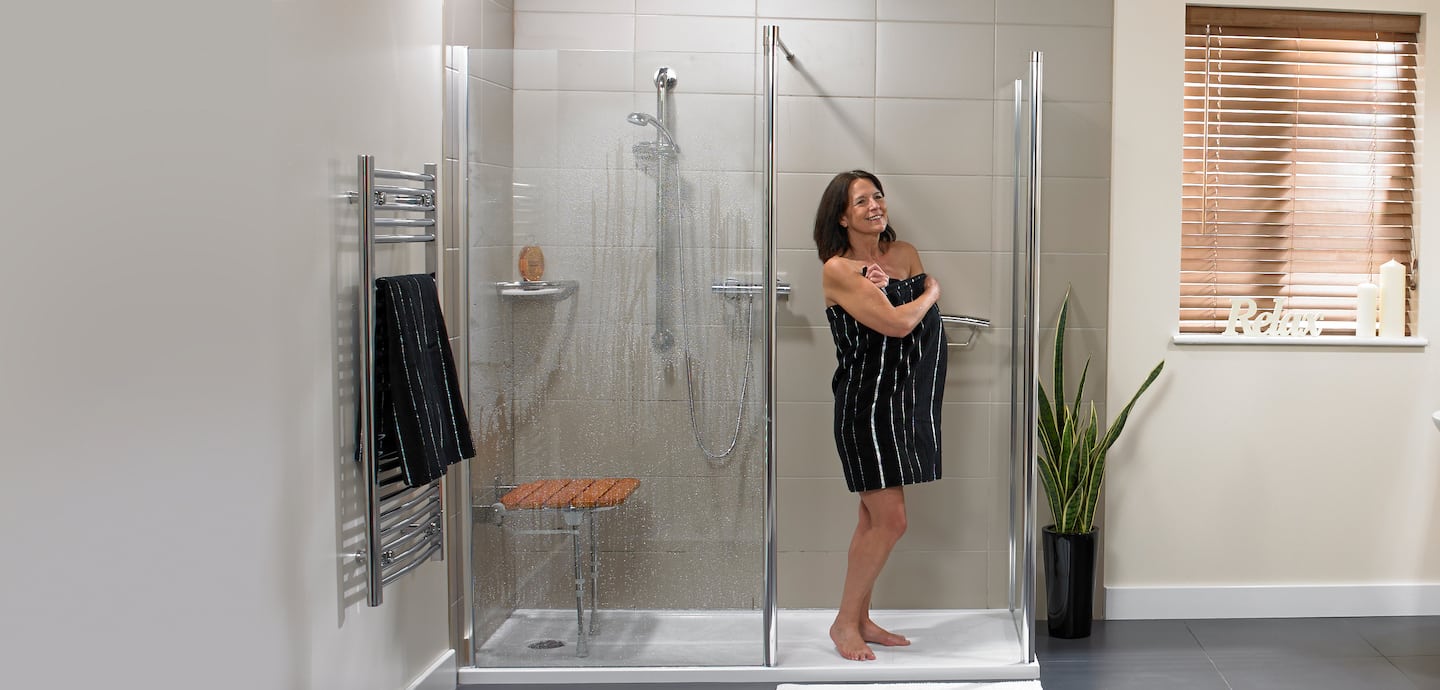Disabled Showers: Our 2023 Expert Guide

Choosing an accessible shower can be challenging for those with disabilities and mobility restrictions. With so many options to consider depending on your mobility needs, it can sometimes feel a little overwhelming. Our guide is here to help you consider the various options and help to select the right shower for your needs.
So, whether you need extra support in the shower to avoid any potential slips or falls or are looking for extra help when entering and exiting your shower unit, a disabled shower could be just the option for you and your household. Read on to find out more.
Are you affected by mobility issues when bathing?
Fill out the form in seconds and discover our full range of assisted bathing showers and baths.

- What are disabled showers?
- Do you need a disabled shower?
- What is a Disabled Shower Cubicle / Walk-In Shower?
- What is a wet room?
- What is an Over-Bath Shower?
- Additional Features for Disabled Showers
- Further Surfaces and Features to Assist with Mobility Issues
What are disabled showers?
Firstly, it is important to outline what exactly showers for disabled users look like and just how much they may be able to assist when it comes to your bathing needs.
Offered in a variety of ways based on your requirements, these types of showers are usually available as one of three options, as below:
- As a disabled shower cubicle, also known as a disability walk-in shower
- Integrated as part of a wet room
- Over an accessible bath tub
Depending on which shower best suits your needs will depend on various factors.
Do you need a disabled shower?
If you have a disability, searching for walk-in showers can feel overwhelming due to numerous considerations. With so much on offer, from size to style and various features required, there is a whole world of options to choose from.
When considering if you might need a disabled shower, there are various questions you can ask yourself, such as:
Your current bathroom and shower size
The options available to you will vary based on the size and shape of your bathroom and the area in which you choose for installation.
What type of disability do you have, and what type of disability walk-in showers would work best for you / which specific features would help with your mobility showering needs?
It may sound obvious to consider the type of disability you have alongside your current needs. However, this is a critical step to consider.
As an example, if you use a wheelchair or require a seated position, the height of your shower and subsequent controls may need to be lower, and a shower screen may be out of the question.
Your own personal style
It goes without saying that you will likely have a certain way in which you want your bathroom to look and will have an idea of the type of shower you wish to have installed.
Many options are available in different finishes and with different support features. Where possible, you will want to find one that matches your current bathroom and your own personal style.
Whether the shower will be sole use or if anyone else will require its use
You may be thinking of installing a shower purely for your own mobility needs. However, if others in your household use the area, you may need to consider the space and additional features required for multi-use.
In instances such as these, you may wish to consider a wet room instead.
So, how can disabled showers help with your mobility showering needs? We have outlined the key details of each of the three main options to help you better understand which could be best for you.
What is a Disabled Shower Cubicle / Walk-In Shower?
A disabled shower cubicle / walk-in shower is also known as a level access shower. These types of showers are designed as standalone shower units and are usually featured in mobility wet rooms.
They are essentially a shower either with a low-level tray or zero-threshold entry.
As the shower tray is either a lower entry or level with the bathroom floor, it helps to eliminate any hazards that could take place at floor level, such as in your existing shower cubicle. This form of shower provides users with essentially, a large shower with no restraints on space.
How does it help accessibility?
Disabled shower cubicles ensure that users can still make use of a large shower area, as there are no restraints on space due to its installation. Mobility shower accessibility is made easier for those with disabilities and mobility issues, this form of shower offers safety while bathing and fewer ways of tripping and falling.
Disability walk-in showers typically come with grab rails, anti-slip flooring, and other safety and accessibility features to ensure an enhanced bathing experience for people with limited mobility. Disability walk-in showers are ideal for wheelchair users, as they support various, safe methods of entry and exit.
What is a wet room?
If access is at the top of your list when considering a disabled bathing experience, you may wish to look into a wet room. A wet room is a type of bathroom that is designed to be entirely waterproof, without any doors or physical barriers between the shower and the rest of the room.
As an alternative to disability walk-in showers, wet rooms are a popular choice for those who want a spacious feel, and they are ideal for elderly persons who may need a little extra space when showering.
Do wet rooms have easy access for wheelchairs or crutches?
The installation of a completely waterproofed, level walk-in floor ensures easy and safe access to the showering area. This means significantly fewer falls associated with a shower cubicle or walk-in shower with a step.
Wet rooms are also much easier to clean and maintain. This makes them a great choice for users who are mobility-challenged and wheelchair users. However, in these instances, you will need to ensure the extra room is factored in compared to a standard wet room will also be required in the area to allow for some manoeuvrability of the wheelchair.
Wet rooms can also be an ideal choice if you are considering any future needs and requirements for your or another user's bathing experience. As an example, a user could require the use of a wheelchair when showering in the near future. This will have an impact on the space, area for installation and the type of undertray required.
What is an Over-Bath Shower?
An over-bath shower is essentially a shower mounted above a bathtub. It is not designed in the same way as a standalone shower cubicle as users will need to be able to access the bath first.
Over-bath showers require the use of a shower screen or curtain to prevent any water from escaping out of the bath. If you have a disability, getting in and out of a bath may be difficult, so this option will only be suitable combined with a walk-in bath or bath with hoist available.
How does it help with your mobility showering needs?
Out of the three options when considering showers for disabled users, an over-bath shower tends to come in last. This is due to the various accessibility issues that can be presented, particularly with its entry and exit points.
As an over-bath shower requires its users to climb in and out of the bath, as well as the ability to stand for several minutes at a time means it is not possible for everybody. It also is not suitable for wheelchair users.
This type of disabled shower will allow other household users to utilise the shower in the same way as before, though not the preferred option for those with any mobility issues.
Additional features for Disabled Showers
As a shower is more than just water coming out of an overhead nozzle, there are various factors to consider when making any bathroom adaptations or upgrading to a disabled shower.
For example, you may require the use of an adjustable shower head holder to raise or lower to a desired height for existing over-bath showers, or you may require various additional safety features to ensure a more accessible and safe showering experience.
Showers for disabled users can be tricky, as it can be difficult to get in and out of showers if you have mobility issues. In these cases, there are additional features which can help to make your showering experience easier, safer, and more accessible:
-
Grab Rails
Grab bars can be installed in disabled showers to help provide stability and extra support if your balance is poor when standing. These are often placed on walls around the shower/bath area.
-
Horizontal Rails
The types of rails are ideal for walk-in showers as they can help you push up from a sitting position. If you or the user requires any additional support when sitting down, these types of rails can be installed within your shower.
-
Vertical Rails
These rails can also be placed around the bathroom for extra support, and if you require assistance to help you from slipping while showering, you can choose to have these installed next to a shower seat.
-
Shower Benches
A shower bench, also known as a shower seat, sits inside a cubicle and is used once inside. These can be offered in a range of styles. For example, fixed to the wall, standalone with anti-slip feet, or built into the unit itself. These types of seats can be extremely advantageous for disabilities such as arthritis.
-
Wall-mounted Seats
These types of seats can easily be installed into a disabled shower cubicle or wet room and can be offered in two ways; static or hinged. If you require back support and armrests, these are an ideal choice.
-
Shower Chairs
This particular additional safety feature can be offered in a whole variety of shapes and sizes and they are a great choice if you require a bit of extra seated support while showering. Shower seats will usually come with rubber cups at the bottom of the legs to prevent any slipping and can either be static or mobile.
Further surfaces and features to assist with mobility issues
To further help with disabilities and any mobility issues, many users opt to install anti-slip flooring in their walk-in disabled shower cubicle or wet room. As safety is one of the key considerations when showering, this option ensures you can both enter and exit with peace of mind. Including this type of flooring can also help to provide a more comfortable bathing experience in the absence of any slips, trips and falls.
Showers for disabled users also need to take into consideration whether they are ideal for wheelchair users and anyone who requires a little extra support when entering and exiting the shower. As mentioned above, there are various seating options you can install to ensure a safe and more accessible experience. Some users choose to install a power seat, which can help wheelchair users to transition directly from their wheelchair.
There are also heating options to consider. When choosing your shower unit, you can opt for a thermostatic mixer shower. This option preheats the water from your boiler or hot water tank and automatically rectifies any pressure changes. As well as ensuring an enjoyable shower experience, these types of showers can help to avoid any nasty burns or scalds if another person in the house turns on the cold water tap.
For further assistance, you can also choose to have electric showers installed. These types of showers are ideal to keep your shower operating at a consistent temperature. Helping to minimise any further concerns, this ensures you can focus on enjoying your new bathing experience in comfort.
